2011 JEEP GRAND CHEROKEE height
[x] Cancel search: heightPage 86 of 587
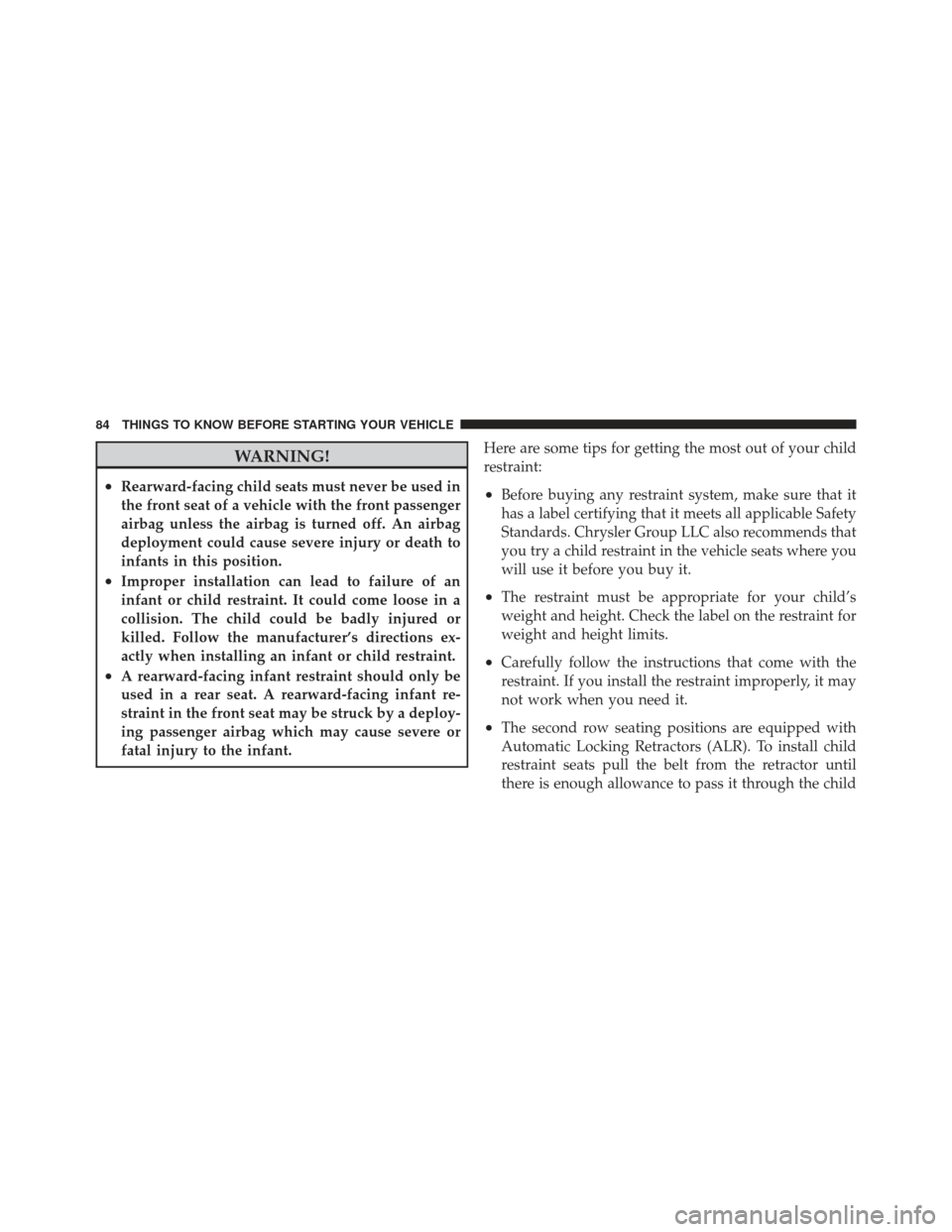
WARNING!
•Rearward-facing child seats must never be used in
the front seat of a vehicle with the front passenger
airbag unless the airbag is turned off. An airbag
deployment could cause severe injury or death to
infants in this position.
•Improper installation can lead to failure of an
infant or child restraint. It could come loose in a
collision. The child could be badly injured or
killed. Follow the manufacturer’s directions ex-
actly when installing an infant or child restraint.
•A rearward-facing infant restraint should only be
used in a rear seat. A rearward-facing infant re-
straint in the front seat may be struck by a deploy-
ing passenger airbag which may cause severe or
fatal injury to the infant.Here are some tips for getting the most out of your child
restraint:
•Before buying any restraint system, make sure that it
has a label certifying that it meets all applicable Safety
Standards. Chrysler Group LLC also recommends that
you try a child restraint in the vehicle seats where you
will use it before you buy it.
•The restraint must be appropriate for your child’s
weight and height. Check the label on the restraint for
weight and height limits.
•Carefully follow the instructions that come with the
restraint. If you install the restraint improperly, it may
not work when you need it.
•The second row seating positions are equipped with
Automatic Locking Retractors (ALR). To install child
restraint seats pull the belt from the retractor until
there is enough allowance to pass it through the child
84 THINGS TO KNOW BEFORE STARTING YOUR VEHICLE
Page 125 of 587
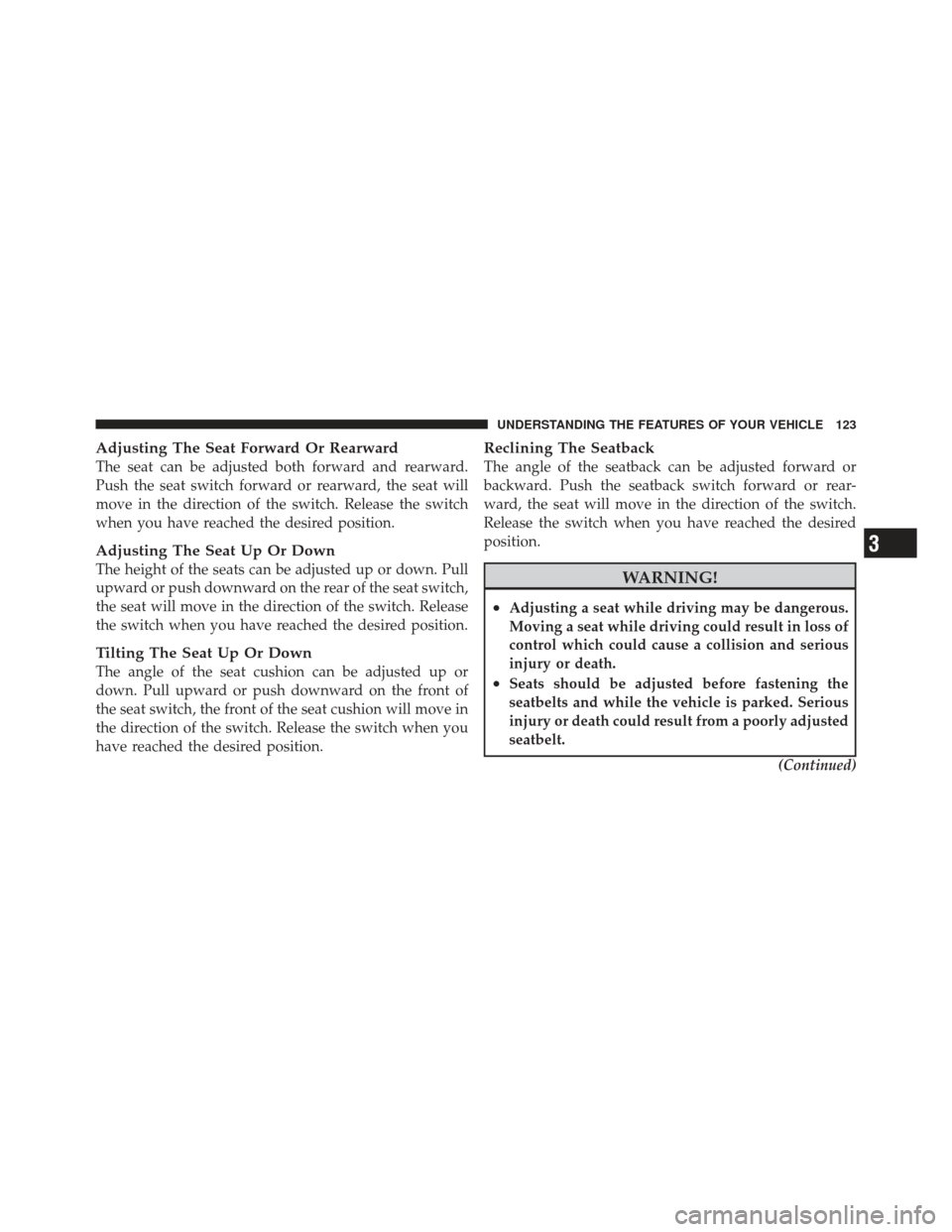
Adjusting The Seat Forward Or Rearward
The seat can be adjusted both forward and rearward.
Push the seat switch forward or rearward, the seat will
move in the direction of the switch. Release the switch
when you have reached the desired position.
Adjusting The Seat Up Or Down
The height of the seats can be adjusted up or down. Pull
upward or push downward on the rear of the seat switch,
the seat will move in the direction of the switch. Release
the switch when you have reached the desired position.
Tilting The Seat Up Or Down
The angle of the seat cushion can be adjusted up or
down. Pull upward or push downward on the front of
the seat switch, the front of the seat cushion will move in
the direction of the switch. Release the switch when you
have reached the desired position.
Reclining The Seatback
The angle of the seatback can be adjusted forward or
backward. Push the seatback switch forward or rear-
ward, the seat will move in the direction of the switch.
Release the switch when you have reached the desired
position.
WARNING!
•Adjusting a seat while driving may be dangerous.
Moving a seat while driving could result in loss of
control which could cause a collision and serious
injury or death.
•Seats should be adjusted before fastening the
seatbelts and while the vehicle is parked. Serious
injury or death could result from a poorly adjusted
seatbelt.(Continued)
3
UNDERSTANDING THE FEATURES OF YOUR VEHICLE 123
Page 126 of 587

WARNING! (Continued)
•Do not ride with the seatback reclined so that the
shoulder belt is no longer resting against your
chest. In a collision you could slide under the seat
belt, which could result in serious injury or death.
CAUTION!
Do not place any article under a power seat or
impede its ability to move as it may cause damage to
the seat controls. Seat travel may become limited if
movement is stopped by an obstruction in the seat’s
path.
Passenger’s Power Seat
Some models are equipped with a six-way power pas-
senger seat. The power seat switch is located on the
outboard side of the seat. The switch is used to control
the movement of the seat and seat cushion.
Adjusting The Seat Forward Or Rearward
The seat can be adjusted both forward and rearward.
Push the seat switch forward or rearward, the seat will
move in the direction of the switch. Release the switch
when you have reached the desired position.
Adjusting The Seat Up Or Down
The height of the seats can be adjusted up or down. Pull
upward or push downward on the seat switch, the seat
will move in the direction of the switch. Release the
switch when you have reached the desired position.
124 UNDERSTANDING THE FEATURES OF YOUR VEHICLE
Page 151 of 587
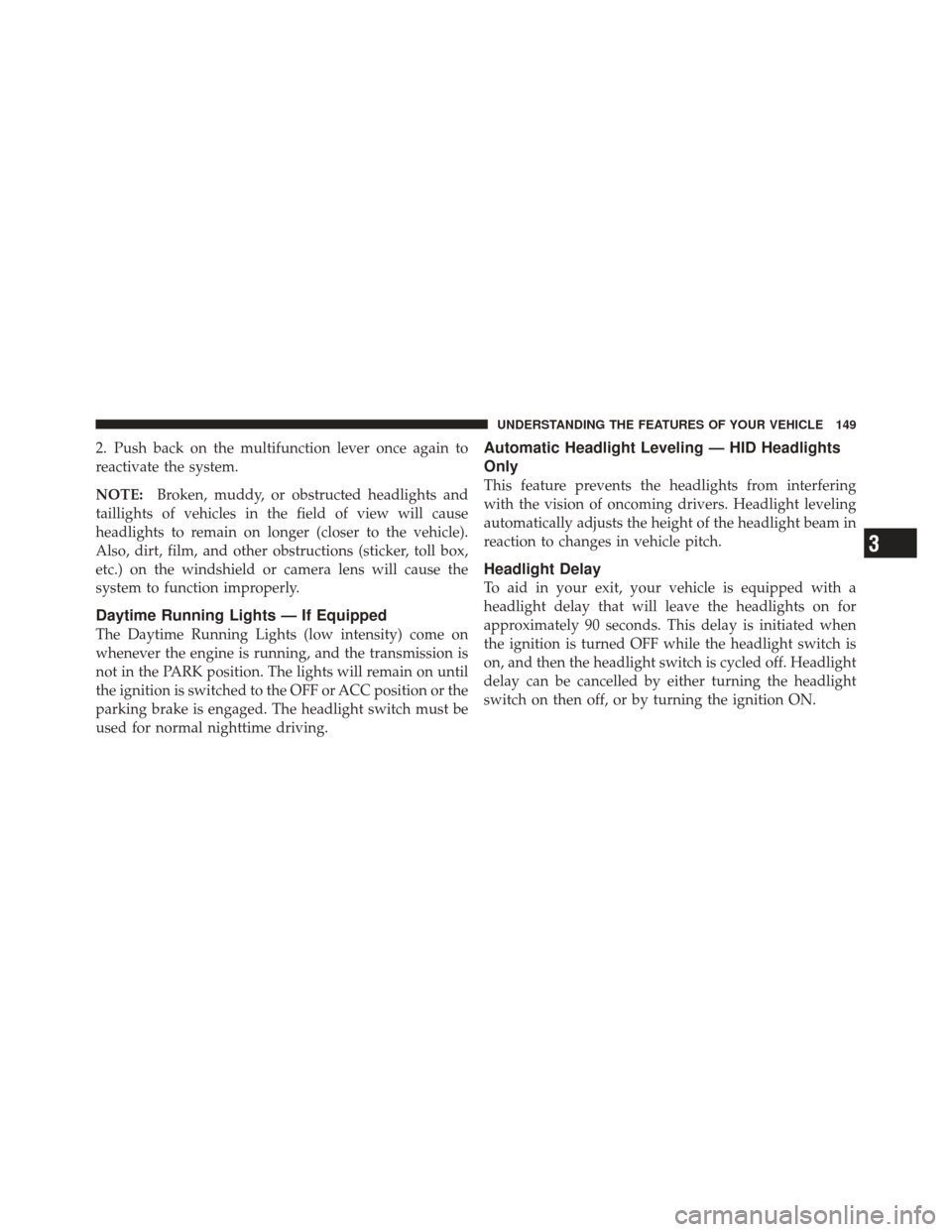
2. Push back on the multifunction lever once again to
reactivate the system.
NOTE:Broken, muddy, or obstructed headlights and
taillights of vehicles in the field of view will cause
headlights to remain on longer (closer to the vehicle).
Also, dirt, film, and other obstructions (sticker, toll box,
etc.) on the windshield or camera lens will cause the
system to function improperly.
Daytime Running Lights — If Equipped
The Daytime Running Lights (low intensity) come on
whenever the engine is running, and the transmission is
not in the PARK position. The lights will remain on until
the ignition is switched to the OFF or ACC position or the
parking brake is engaged. The headlight switch must be
used for normal nighttime driving.
Automatic Headlight Leveling — HID Headlights
Only
This feature prevents the headlights from interfering
with the vision of oncoming drivers. Headlight leveling
automatically adjusts the height of the headlight beam in
reaction to changes in vehicle pitch.
Headlight Delay
To aid in your exit, your vehicle is equipped with a
headlight delay that will leave the headlights on for
approximately 90 seconds. This delay is initiated when
the ignition is turned OFF while the headlight switch is
on, and then the headlight switch is cycled off. Headlight
delay can be cancelled by either turning the headlight
switch on then off, or by turning the ignition ON.
3
UNDERSTANDING THE FEATURES OF YOUR VEHICLE 149
Page 266 of 587
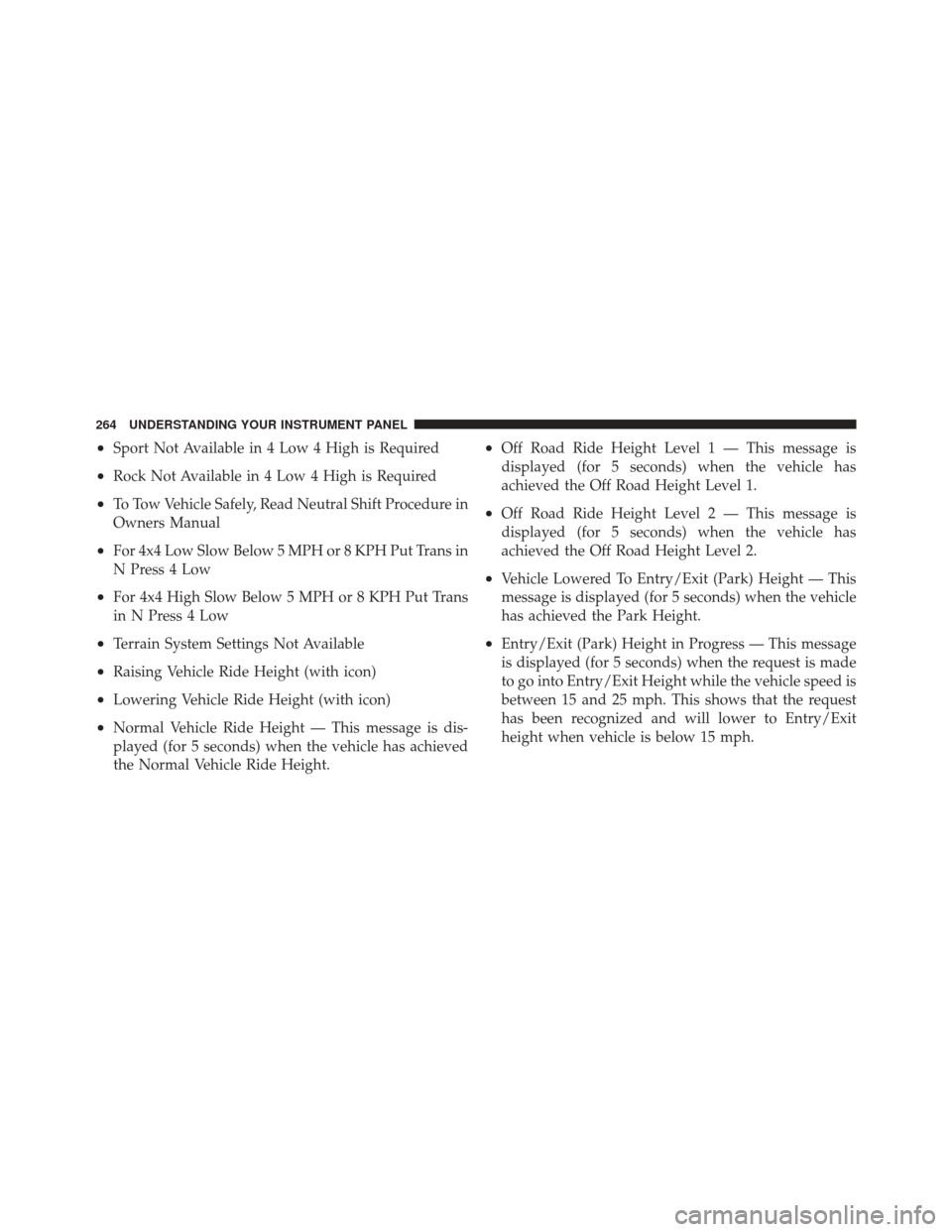
•Sport Not Available in 4 Low 4 High is Required
•Rock Not Available in 4 Low 4 High is Required
•To Tow Vehicle Safely, Read Neutral Shift Procedure in
Owners Manual
•For 4x4 Low Slow Below 5 MPH or 8 KPH Put Trans in
N Press 4 Low
•For 4x4 High Slow Below 5 MPH or 8 KPH Put Trans
in N Press 4 Low
•Terrain System Settings Not Available
•Raising Vehicle Ride Height (with icon)
•Lowering Vehicle Ride Height (with icon)
•Normal Vehicle Ride Height — This message is dis-
played (for 5 seconds) when the vehicle has achieved
the Normal Vehicle Ride Height.
•Off Road Ride Height Level 1 — This message is
displayed (for 5 seconds) when the vehicle has
achieved the Off Road Height Level 1.
•Off Road Ride Height Level 2 — This message is
displayed (for 5 seconds) when the vehicle has
achieved the Off Road Height Level 2.
•Vehicle Lowered To Entry/Exit (Park) Height — This
message is displayed (for 5 seconds) when the vehicle
has achieved the Park Height.
•Entry/Exit (Park) Height in Progress — This message
is displayed (for 5 seconds) when the request is made
to go into Entry/Exit Height while the vehicle speed is
between 15 and 25 mph. This shows that the request
has been recognized and will lower to Entry/Exit
height when vehicle is below 15 mph.
264 UNDERSTANDING YOUR INSTRUMENT PANEL
Page 267 of 587
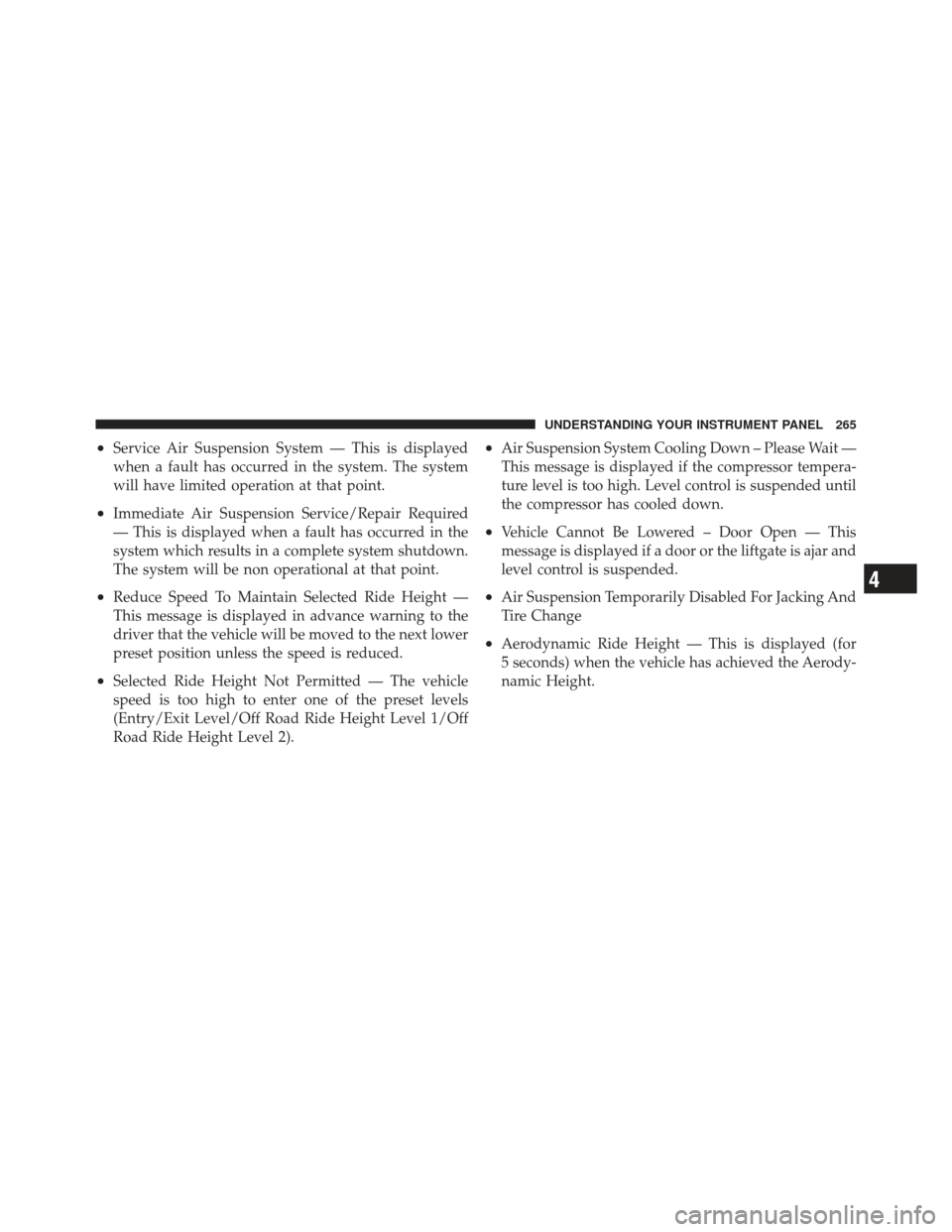
•Service Air Suspension System — This is displayed
when a fault has occurred in the system. The system
will have limited operation at that point.
•Immediate Air Suspension Service/Repair Required
— This is displayed when a fault has occurred in the
system which results in a complete system shutdown.
The system will be non operational at that point.
•Reduce Speed To Maintain Selected Ride Height —
This message is displayed in advance warning to the
driver that the vehicle will be moved to the next lower
preset position unless the speed is reduced.
•Selected Ride Height Not Permitted — The vehicle
speed is too high to enter one of the preset levels
(Entry/Exit Level/Off Road Ride Height Level 1/Off
Road Ride Height Level 2).
•Air Suspension System Cooling Down – Please Wait —
This message is displayed if the compressor tempera-
ture level is too high. Level control is suspended until
the compressor has cooled down.
•Vehicle Cannot Be Lowered – Door Open — This
message is displayed if a door or the liftgate is ajar and
level control is suspended.
•Air Suspension Temporarily Disabled For Jacking And
Tire Change
•Aerodynamic Ride Height — This is displayed (for
5 seconds) when the vehicle has achieved the Aerody-
namic Height.
4
UNDERSTANDING YOUR INSTRUMENT PANEL 265
Page 366 of 587

to allow more driver control of vehicle while maintain-
ing safe handling controls. The vehicle will lower (if
equipped with Air Suspension) to Aero Mode in High
Range. 4WD Low is not available in SPORT mode, if
4WD Low is selected the Selec-Terrain™ will auto-
matically switch back to AUTO.
•Snow– Tuning set for additional stability in inclement
weather. Use on and off road on loose traction surfaces
such as snow. When in Snow mode (depending on
certain operating conditions), the transmission may
use second gear (rather than first gear) during
launches, to minimize wheel slippage. If equipped
with air suspension, the level will change to Normal
Ride Height (NRH) if the transfer case is in high range.
The level will change to Off-Road 1 if the transfer case
is in Low range.
•Auto – Fully automatic full time four-wheel drive
operation can be used on and off road. Balances traction with seamless steering feel to provide im-
proved handling and acceleration over two-wheel
drive vehicles. If equipped with air suspension, the
level will change to NRH.
•Sand/Mud
– Off road calibration for use on low
traction surfaces such as mud, sand, or wet grass.
Driveline is maximized for traction. Some binding
may be felt on less forgiving surfaces. The electronic
brake controls are set to limit traction control manage-
ment of throttle and wheel spin. If equipped with air
suspension, the level will change to Off-Road 1.
•Rock – Off-road calibration only available in 4WD
Low range. The vehicle is raised (if equipped with Air
Suspension) for improved ground clearance. Traction
based tuning with improved steer-ability for use on
high traction off-road surfaces. Activates the Hill De-
scent Control for steep downhill control. Use for low
speed obstacles such as large rocks, deep ruts, etc. If
364 STARTING AND OPERATING
Page 367 of 587
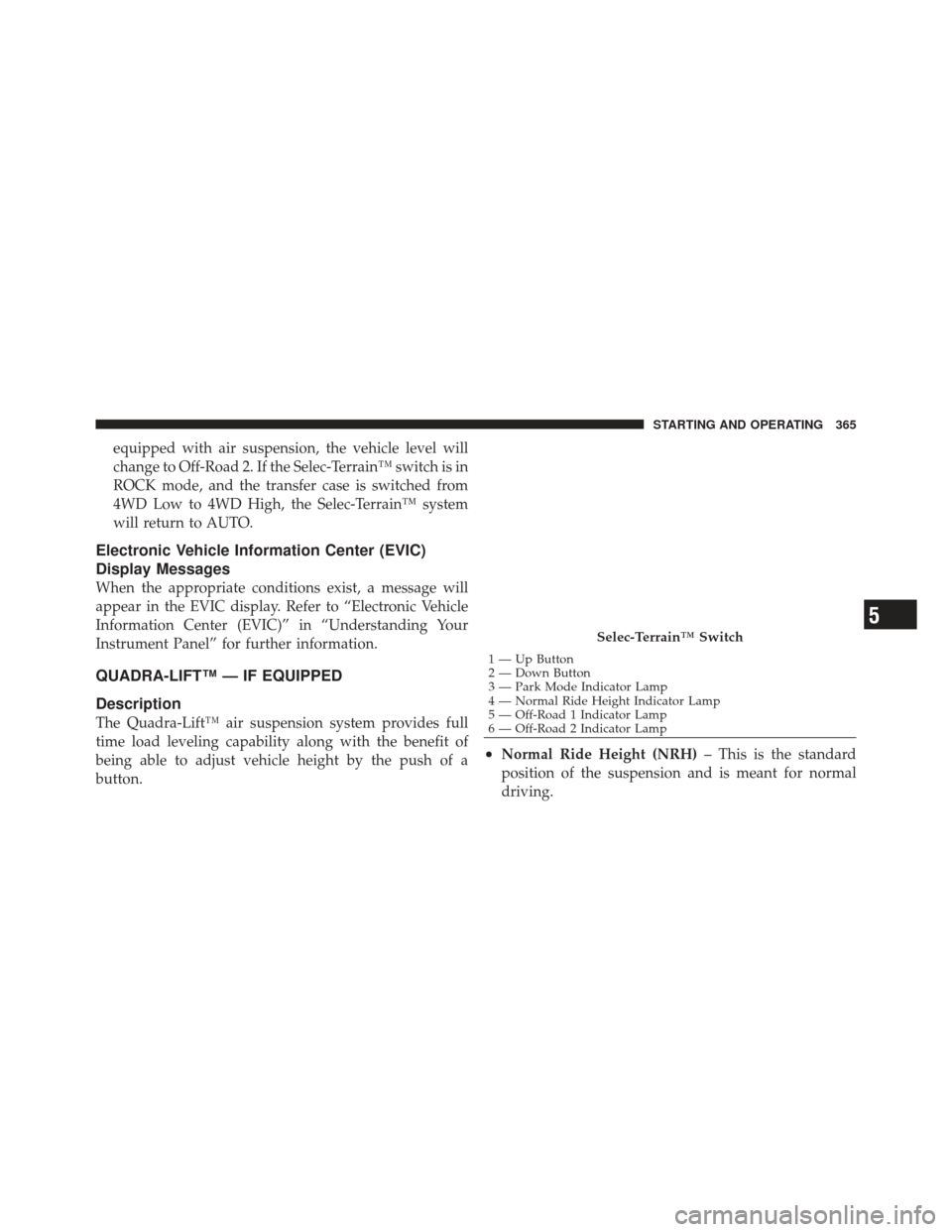
equipped with air suspension, the vehicle level will
change to Off-Road 2. If the Selec-Terrain™ switch is in
ROCK mode, and the transfer case is switched from
4WD Low to 4WD High, the Selec-Terrain™ system
will return to AUTO.
Electronic Vehicle Information Center (EVIC)
Display Messages
When the appropriate conditions exist, a message will
appear in the EVIC display. Refer to “Electronic Vehicle
Information Center (EVIC)” in “Understanding Your
Instrument Panel” for further information.
QUADRA-LIFT™ — IF EQUIPPED
Description
The Quadra-Lift™ air suspension system provides full
time load leveling capability along with the benefit of
being able to adjust vehicle height by the push of a
button.
•Normal Ride Height (NRH)– This is the standard
position of the suspension and is meant for normal
driving.
Selec-Terrain™ Switch
1 — Up Button
2 — Down Button
3 — Park Mode Indicator Lamp
4 — Normal Ride Height Indicator Lamp
5 — Off-Road 1 Indicator Lamp
6 — Off-Road 2 Indicator Lamp
5
STARTING AND OPERATING 365